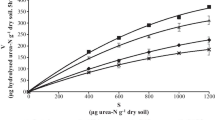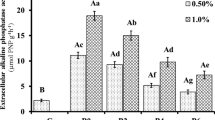Summary
Thiophosphoryl triamide inhibits soil urease activity when added to soil and is under consideration as a fertilizer amendment for retarding hydrolysis of urea fertilizer by soil urease. Work reported showed that this compound is a poor inhibitor of jackbean urease and that its ability to retard soil urease activity is due to its decomposition in soil with formation of phosphoryl triamide, which is a potent inhibitor of urease activity. This conclusion was supported by studies showing a close relationship between the peak area of the 31P-nuclear magnetic resonance (NMR) signal from phosphoryl triamide in thiophosphoryl triamide solutions that had been incubated with soil for various times and the ability of these solutions to inhibit jackbean urease activity.
Similar content being viewed by others
References
Bremner JM, Chai HS (1986) Evaluation of N-butyl phosphorothioic triamide for retardation of urea hydrolysis in soil. Common Soil Sci Plant Anal 17:337–351
Chai HS, Bremner JM (1987) Evaluation of some phosphoroamides as soil urease inhibitors. Biol Fertil Soils 3:189–194
Hauck RD (1984) Technological approaches to improving the efficiency of nitrogen fertilizer use by crop plants. In: Hauck RD (ed) Nitrogen in crop production. American Society of Agronomy, Madison, Wisc, pp 551–560
McCarty GW, Bremner JM, Chai HS (1989) Effect of N-(n-butyl) thiophosphoric triamide on hydrolysis of urea by plant, microbial, and soil urease. Biol Fertil Soils 8:123–127
Mulvaney RL, Bremner JM (1981) Control of urea transformations in soils. In: Paul EA, Ladd JN (eds) Soil biochemistry, vol 5. Marcel Dekker, New York, pp 153–196
Nielsen ML, Pustinger JV, Strobel J (1964) Phosphorus-31 nuclear magnetic resonance chemical shifts for phosphorus compounds. J Chem Eng Data 9:167–170
Radel RJ, Gautney J, Peters GE (1988) Urease inhibitor developments. In: Bock B, Kissel D (eds) Ammonia volatilization from urea fertilizers. Tennessee Valley Authority, Muscle Shoals, Alabama, pp 111–136
Voss RD (1984) Potential for use of urease inhibitors. In: Hauck RD (ed) Nitrogen in crop production. American Society of Agronomy, Madison, Wisc, pp 571–577
Zantua MI, Bremner JM (1975) Comparison of methods of assaying urease activity in soils. Soil Biol Biochem 7:291–295
Author information
Authors and Affiliations
Rights and permissions
About this article
Cite this article
McCarty, G.W., Bremner, J.M. Formation of phosphoryl triamide by decomposition of thiophosphoryl triamide in soil. Biol Fert Soils 8, 290–292 (1989). https://doi.org/10.1007/BF00263156
Received:
Issue Date:
DOI: https://doi.org/10.1007/BF00263156




